
MARS SPIRIT ROVER MIXED LIFE
Report #157
February 2, 2009 (updated 2/13/09)
Addendum added to BOTTOM of report
Okay it's time now to abandon the Moon and Earth based investigative evidence tact I've recently been on and get back to some Mars evidence as presented below. All of the evidence in this report is sourced from the Mars Spirit rover science data.
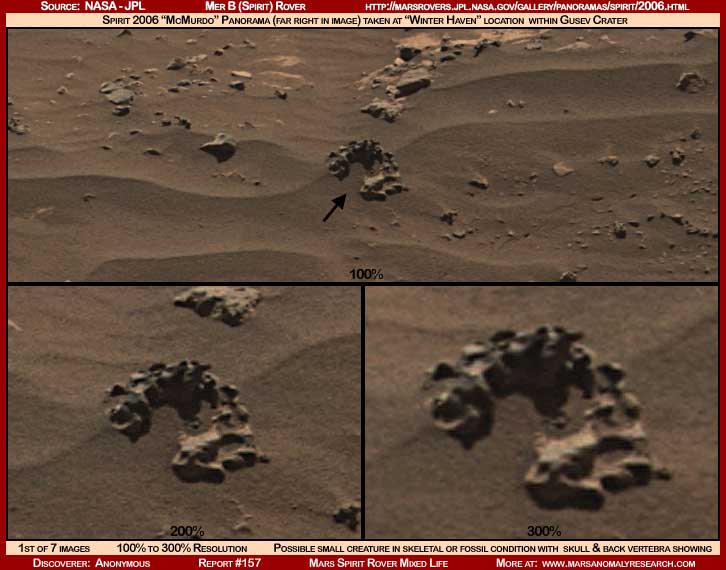
The above first 3-panel image demonstrates
what very suspiciously appears to be a partially visible fossil or old skeletal
remains of a small creature partially buried in the soil. This image and anomaly
was brought to my attention by a viewer who wishes to remain anonymous.
Note that the object is in a tightly curled position. The most notable and
suggestive feature to this effect is what may be a curled line of body vertebra.
The partially worn skull would be pointed toward us on the right end of the
vertebra chain. The tail end curved around on the left is either missing or
out of sight down deeper in the soil.
Now this could be just a chance configuration of worn rock taking this shape.
On the other hand, I'm sure than any paleontologist or archeologist experienced
in field work walking nearby and seeing this would immediately recognize this
for its potential and would quickly alter course to come over and inspect
it. That doesn't make it the remains of a creature but anyone will have to
admit that it is highly suggestive of being the remains of some creature and
worth the look.
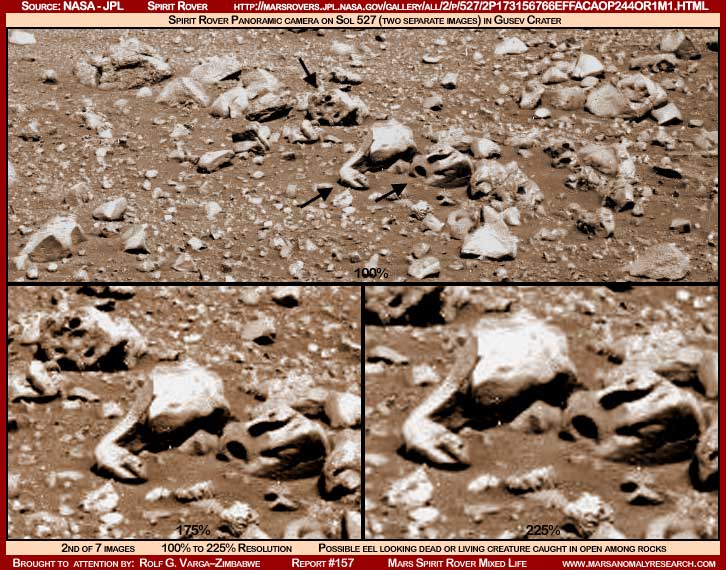
The above second 3-panel image demonstrates
what clearly appears to be an armless legless serpentine creature caught in
the open among the rocks that are likely its home. This image and evidence
was brought to my attention by Rolf Varga of Zimbabwee to the benefit of us
all.
Note the narrow body, flat fluke like tail propped up on the rock with the
end of it discolored, the slightly gapping mouth, and the dark eye socket.
If this is a creature as it appears, it is likely dead and desiccated but
the point is that it may be a creature with flesh on it that was not too long
ago alive on Mars with all the implications of that.
In the top image panel, I want you to notice that black arrows are not only
pointing out the creature but also two very nearby rocks that are unlike other
rocks in this terrain. Both of these rocks and especially the one on the right,
show signs of being hollow with various openings into the hollow interior.
On the rock on the right, please note the darker color surrounding the elliptical
opening on the rock's left. Now note that the end of the creatures tail area
also shows a similar darker color. This suggests that, if this is a creature
as it appears, the creature may have been coming and going from the interior
of this rock via this hole in it.
It may be that the serpentine creature's flattened tail is used like a single
arm leveraging the creature around among the rocks as well as in and out of
this elliptical hole into the protective rock interior with the result of
staining the rock face outside area of the hole. Yes it would seem to be too
effort intensive for practical survival of such a creature ill equipped as
it is to cope with a dry open air environment. That tends to make its presence
here theoretically impossible.
However, do you really trust everything you see
in the rover imaging? In the rover imaging you look out over distant vistas
from the rover and see nothing but dry soil and rocks and never any water.
Do you really believe every bit of such views completely? For example, after
taking a close serious look at my 2008 Report
#141 evidence, do you really believe the distant rover views represent
reality or that some kind of plants exist out there in the distance propagating
themselves via gas bags lifting and traveling on the wind containing spores
or seeds?
It's the same here with this physical terrain. Suppose a nearby body of water
disguised and hidden in the rover imaging overflowed temporarily into this
area carrying this aquatic eel like creature in the flood with it and some
other swimming creatures. Suppose the water remained for a few months and
then gradually dried up. Suppose this poor creature caught in these unfortunate
circumstances and being primarily an aquatic serpentine life form used to
living in holes at ground level was the last to survive struggling around
in the increasingly shallow water living off of other swimming creatures that
were dying.
Finally, there is nothing left to eat in the tiny amount of water that is
left and this creature must itself succumb stranded out in the open just outside
its temporary din. In a rapid drying process the flesh does not rot off of
the bones but desiccates into the condition you see here and the body survives
intact perhaps for years. The visual evidence is here in front of you. You
must decide what may represent truth and what does not.
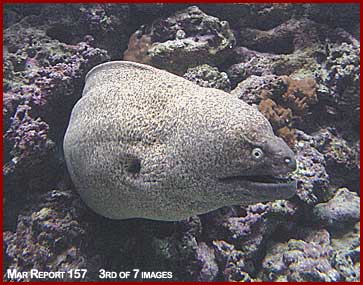 ..
..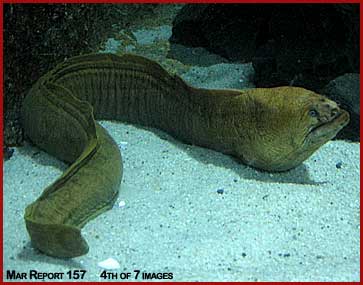
www.alohafriendshawaii.com/arsnorkeling.html
........................ www.mrupp.info/photos_2005australia.html
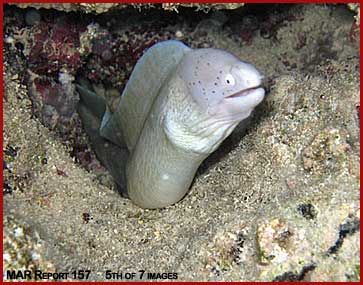 ..
..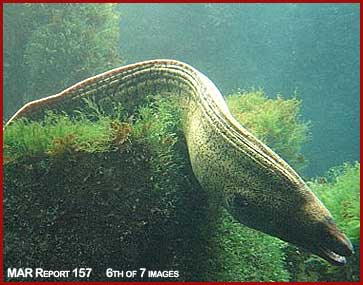
http://seafishes.wordpress.com/tag/red-sea/page/3................................hhttp://www.unplugyourkids.com.............
The above #3 through #6 images are
examples of various Earth based living and healthy moray eels. The visual
resemblance to the Mars image #2 evidence is quite obvious, especially if
you take into consideration the shrinking and flattening deformity that may
happen in the Mars body desiccation process. Note that the two left images
demonstrate the Earth aquatic eels inside their holes while the two right
images demonstrate these powerful eels with most of their body being visible.
I've been swimming around them at times and it always amazed me what a tiny
hole such a big moray eel could get into and come out of. I've seen huge ones
wrapped around inside a jar or can that I wouldn't have believed one half
their size could have fit into. Sometimes they are actually friendly but,
as a diver, you want to be careful crossing too near one's hole in the coral
and especially if water visibility is poor. Your arm passing by in front of
its hole can be mistaken as food. If they strike and latch on, they stay latched
on, they are nearly impossible to get off, and far too powerful for you to
pull them out of the hole.
On the other hand, note that the Earth moray eels typically have a hole on
their side well back of the head area. This is a valve from which water is
expelled and there are actually gills back in this area. Water comes in through
the gapping mouth, crosses through the gills, and is expelled out of this
hole/valve in close quarters well behind the head so that blown ground debris
in close quarters is minimized around the head and eyes.
Now, although the rover imaging is too poor resolution wise to be definitive
about this, note that we do not see this hole or valve visible on the Mars
eel like creature. It may be there but just plastered shut as the carcass
compacts, solidifies, and flattens as it desiccates. It also may be there
but the carcass is just to light reflective and bright to see such small detail.
On the other hand, is it possible that this Mars creature evolved from Mars
eel aquatic stock and adapted to sand/soil life exposed to open air conditions?
Could it be possible that such an adapted creature could function with that
paddle like tail pushing and propelling itself first through mud and then
later adaptation through the sand/soil? Remember, this is a entirely different
world with its own evolutionary paths. For all we know there could even be
a muddy and watery world not too far below the surface we see. The creature
may come up from that world under the rock for protection and make forays
out in the open from that rock protection.
Well so much for consideration of the Mars eel like creature visual evidence.
Now let's move on to some life evidence as growth on some rocks that is going
to be hard to deny unless your psychology is just into denial.
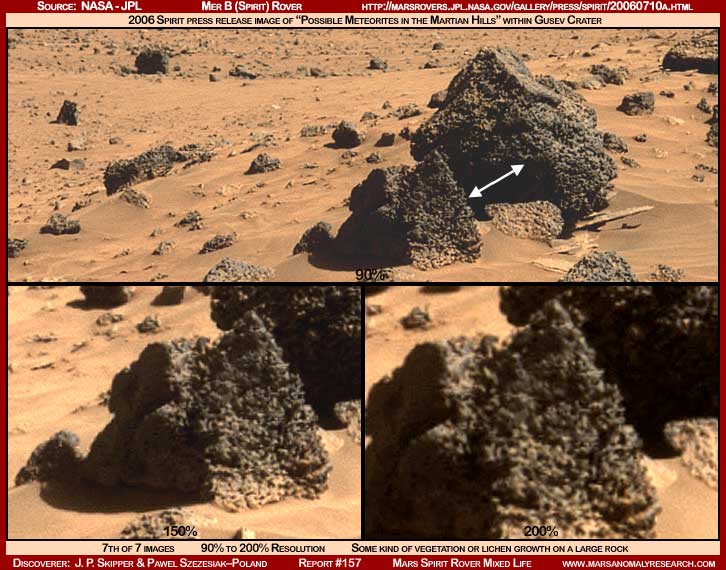
The above seventh report 3-panel
Mars Spirit rover image says it all. It is some of the bio-life evidence that
I had been holding back for inclusion in the first book I'm about to release.
I include it here because the book evidence must be in poor print quality
black and white not showing it off as its best whereas the color tint you
see here is more revealing. By the way, as an aside and to his credit this
image but not this particular evidence was also brought to my attention by
Pawel Szezesiak of Ostrowite, Poland exploring other features in it.
It demonstrates some kind of vegetation or lichen growth especially prominent
on one of the rocks so that just enough detail of it can be seen and recognized.
This is taken from a NASA/JPL press release image. The false color in that
official image for the evidence is a very unrealistic dark blue false color
added at official level. I removed that false color and added a more realistic
color tint as well as lightening and sharpening it up some for increased clarity
but nothing else. Note that the above 150% and 200% panel images are especially
telling.
This original dark blue false color of the evidence brings up a point. As
most of you know the real true color of living objects frequently gives them
away as far as the human eye being able to identify such evidence is concerned.
For example, much of vegetative life is a green color for reasons most of
you are familiar with. On the other hand, lichen life for example works on
a little different symbiotic principle often demonstrating fairly strong yellows,
browns, grays, and even reds. The official position would have us believe
that the rover imaging is only in black and white and not in color and that
they know what kind of false color to add to an image. If you really completely
believe that, I have a large bridge that I would like to sell you at a bargain
price.
If you wanted to obfuscated image of life evidence in general, producing faithful
color images for the public and scientists to view would be a big no no. If
you wanted to obfuscate images to prevent recognition of most life in general,
you would obtain faithful color images for your own purposes but would publicly
release only science data images desaturated of color. Black and white and
various shades of gray alone does a very good job of hiding life evidence.
Likewise, adding an overall false color tint such as the dark blue also does
a decent job of hiding living evidence.
Lichen and life like that growing on Mars rocks often consists of rounded
lumpy textures that in monochrome imaging including false color tint is very
hard to distinguish from the true rock's surface and especially when the rocks
are more weather worn with many pits in them. On the other hand, pitted rocks
tend to trap and accumulate nutrients blown on the wind in the small crevasses
and holes and life loves to attach to this type of rock. Yet most of the time
in the monochrome imaging, it is hard to identify and I usually pass over
it knowing that too few viewers will be able to recognize it.
The above 7th image evidence is different. The growth on this rock is considerable
and it has cooperated with us visually by being the spriggy twiggy type like
a miniature tangled forest mass as opposed to the rounded lumpy texture rock
hugging type. Further, a twiggy branching portion of the mass is profiled
and can be seen against a smooth dark shadow background that tends to make
its twiggy nature stand out in sharp contrast against that background. There
is little chance that any viewers except those in denial will mistake or confuse
this growth on the rock imaged here with a rough pitted or lumpy rock surface.
So while some scientist debate the question of microbial evidence in Mars
meteorite rock and also anomalous methane gas pockets in the atmosphere that
suggests the possible presence of life sources somewhere on Mars and as the
secrecy agenda gradually prepares the way for change in these tiny incremental
foot dragging steps, look here at what is right under their noses.
When you observe living evidence like this, now you do still believe the official
position and instrument data that the Mars atmosphere is 95.32% carbon dioxide
with only trace amounts of nitrogen, oxygen, and water so essential to life
as we know it here on Earth don't you? If so, let's talk bridges.
ADDENDUM (2/13/2009)
Normally I report only evidence that I feel will be obvious enough
for most viewers to recognize. Often this leaves other objects in scenes that
I regard as suggestive or even highly suggestive but not quite of the quality
to point out for public exposure here in this arena and then viewers sometimes
bring them to my attention. It seems that quite a few viewers are seeing a
second potential eel or fish in this report's above second image, left panel,
175% image. So I'm including a closer 250% view of that panel as below.
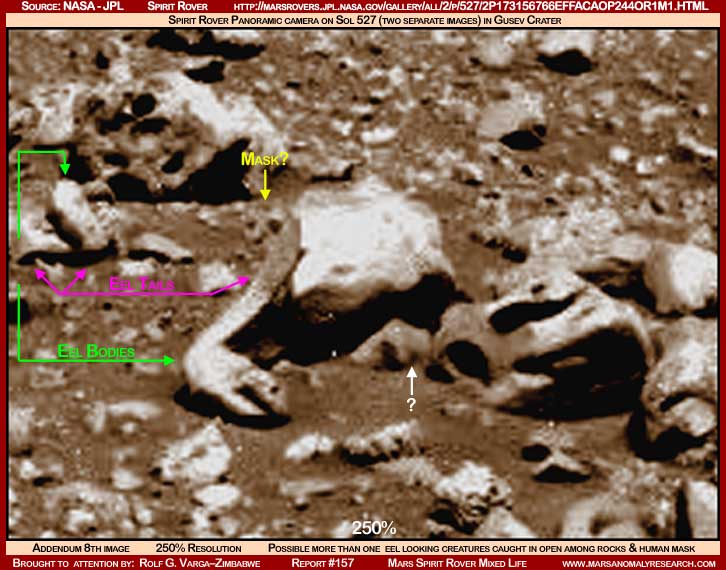
As I say, the additional object
in primary observation by others is on the left side of the above addendum
image. Note that I have subdued sunlight reflectivity and its glare so that
better detail can stand out. Most see a second eel possibly on its back (belly
up) with its also flat fluke like tail curved around toward the left edge
of the image in shadow. Some also see this as a possible fish. Obviously this
could also be a configuration of rocks and that is why I did not report it
as an possible creature but I include closer views of it here for your inspection
since so many have observed this.
Frankly I anticipated that I would hear more about the human or humanoid appearing
upright face or mask at the left side of the eel's tail pointed out by the
yellow arrow as it is actually more obvious. However, surprisingly, I'm hearing
more about the eel/fish looking object and less on the face. A few also comment
that the primary eel looking object is actually a tool or a handle broken
off of something else and therefore equipment rather than life. Maybe but
I Iean in favor of something previously alive and now dead. The hole openings
in the nearby rocks covered with soil staining strongly indicate this creature's
comings and goings.
There is also another object pointed out by a white arrow. It seems to have
a smooth shiny surface that is suggestive of being of a partially translucent
material sort of like alabaster. It might be a artificially worked vase, perhaps
a shell for some creature worn smooth like this, or it may just be another
natural rock. In any case, I thought I would point it out since it is in this
closer view scene. You must decide for yourself whether any of these additional
items have any merit or not.
DOCUMENTATION
http://marsrovers.jpl.nasa.gov/gallery/panoramas/spirit/2006.html:
This link takes you to the Mars rover 2006 "McMurdo" panorama from
Spirit's "Winter Haven" parked for the Mars winter location official
science data. I used the third listed image on that page. In that third image,
there are three images available there and the one this report's imaging was
drawn from is the largest 87.3 MB image. The possible skeletal creature evidence
is located in the far right of this very wide mosaic image.
http://marsrovers.jpl.nasa.gov/gallery/all/2/p/527/2P173156766EFFACA0P2440R1M1.HTML:
This link takes you to the Mars Spirit rover right panoramic camera Sol 527
official science data image. The eel looking creature evidence is just right
of center. There is also a second image of this scene on this same Sol 527
date from the left panoramic camera but they are essentially the same.
http://marsrovers.jpl.nasa.gov/gallery/press/spirit/20060710a.html:
This link takes you to a Mars Spirit rover press release page. The source
image is the first one listed at the date "10-Jul-2006" and titled
"Possible Meteorites in the Martian Hills (False Color)." There
are three images listed here and my images are sourced from the largest 4.6
MB image. The rock growth evidence is located in the upper part of the image
just right of center. Note that the evidence is falsely and unrealistically
colored a dark blue which I removed and changed to a more normal color tint.
www.marsanomalyresearch.com
![]()